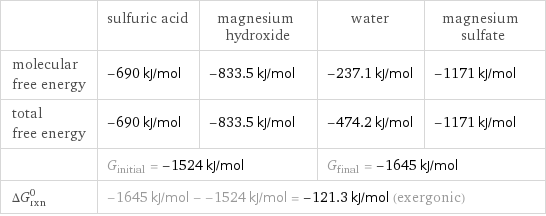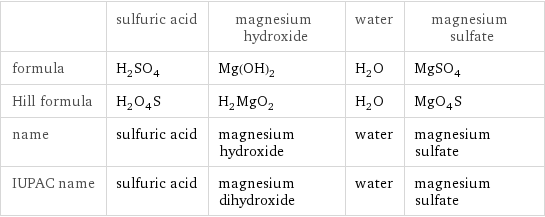Input interpretation

H_2SO_4 (sulfuric acid) + Mg(OH)_2 (magnesium hydroxide) ⟶ H_2O (water) + MgSO_4 (magnesium sulfate)
Balanced equation

Balance the chemical equation algebraically: H_2SO_4 + Mg(OH)_2 ⟶ H_2O + MgSO_4 Add stoichiometric coefficients, c_i, to the reactants and products: c_1 H_2SO_4 + c_2 Mg(OH)_2 ⟶ c_3 H_2O + c_4 MgSO_4 Set the number of atoms in the reactants equal to the number of atoms in the products for H, O, S and Mg: H: | 2 c_1 + 2 c_2 = 2 c_3 O: | 4 c_1 + 2 c_2 = c_3 + 4 c_4 S: | c_1 = c_4 Mg: | c_2 = c_4 Since the coefficients are relative quantities and underdetermined, choose a coefficient to set arbitrarily. To keep the coefficients small, the arbitrary value is ordinarily one. For instance, set c_1 = 1 and solve the system of equations for the remaining coefficients: c_1 = 1 c_2 = 1 c_3 = 2 c_4 = 1 Substitute the coefficients into the chemical reaction to obtain the balanced equation: Answer: | | H_2SO_4 + Mg(OH)_2 ⟶ 2 H_2O + MgSO_4
Structures

+ ⟶ +
Names

sulfuric acid + magnesium hydroxide ⟶ water + magnesium sulfate
Reaction thermodynamics
Enthalpy

| sulfuric acid | magnesium hydroxide | water | magnesium sulfate molecular enthalpy | -814 kJ/mol | -924.5 kJ/mol | -285.8 kJ/mol | -1285 kJ/mol total enthalpy | -814 kJ/mol | -924.5 kJ/mol | -571.7 kJ/mol | -1285 kJ/mol | H_initial = -1739 kJ/mol | | H_final = -1857 kJ/mol | ΔH_rxn^0 | -1857 kJ/mol - -1739 kJ/mol = -118.1 kJ/mol (exothermic) | | |
Gibbs free energy

| sulfuric acid | magnesium hydroxide | water | magnesium sulfate molecular free energy | -690 kJ/mol | -833.5 kJ/mol | -237.1 kJ/mol | -1171 kJ/mol total free energy | -690 kJ/mol | -833.5 kJ/mol | -474.2 kJ/mol | -1171 kJ/mol | G_initial = -1524 kJ/mol | | G_final = -1645 kJ/mol | ΔG_rxn^0 | -1645 kJ/mol - -1524 kJ/mol = -121.3 kJ/mol (exergonic) | | |
Equilibrium constant
![Construct the equilibrium constant, K, expression for: H_2SO_4 + Mg(OH)_2 ⟶ H_2O + MgSO_4 Plan: • Balance the chemical equation. • Determine the stoichiometric numbers. • Assemble the activity expression for each chemical species. • Use the activity expressions to build the equilibrium constant expression. Write the balanced chemical equation: H_2SO_4 + Mg(OH)_2 ⟶ 2 H_2O + MgSO_4 Assign stoichiometric numbers, ν_i, using the stoichiometric coefficients, c_i, from the balanced chemical equation in the following manner: ν_i = -c_i for reactants and ν_i = c_i for products: chemical species | c_i | ν_i H_2SO_4 | 1 | -1 Mg(OH)_2 | 1 | -1 H_2O | 2 | 2 MgSO_4 | 1 | 1 Assemble the activity expressions accounting for the state of matter and ν_i: chemical species | c_i | ν_i | activity expression H_2SO_4 | 1 | -1 | ([H2SO4])^(-1) Mg(OH)_2 | 1 | -1 | ([Mg(OH)2])^(-1) H_2O | 2 | 2 | ([H2O])^2 MgSO_4 | 1 | 1 | [MgSO4] The equilibrium constant symbol in the concentration basis is: K_c Mulitply the activity expressions to arrive at the K_c expression: Answer: | | K_c = ([H2SO4])^(-1) ([Mg(OH)2])^(-1) ([H2O])^2 [MgSO4] = (([H2O])^2 [MgSO4])/([H2SO4] [Mg(OH)2])](../image_source/4cdc74946db7bed176e7f0c74499afde.png)
Construct the equilibrium constant, K, expression for: H_2SO_4 + Mg(OH)_2 ⟶ H_2O + MgSO_4 Plan: • Balance the chemical equation. • Determine the stoichiometric numbers. • Assemble the activity expression for each chemical species. • Use the activity expressions to build the equilibrium constant expression. Write the balanced chemical equation: H_2SO_4 + Mg(OH)_2 ⟶ 2 H_2O + MgSO_4 Assign stoichiometric numbers, ν_i, using the stoichiometric coefficients, c_i, from the balanced chemical equation in the following manner: ν_i = -c_i for reactants and ν_i = c_i for products: chemical species | c_i | ν_i H_2SO_4 | 1 | -1 Mg(OH)_2 | 1 | -1 H_2O | 2 | 2 MgSO_4 | 1 | 1 Assemble the activity expressions accounting for the state of matter and ν_i: chemical species | c_i | ν_i | activity expression H_2SO_4 | 1 | -1 | ([H2SO4])^(-1) Mg(OH)_2 | 1 | -1 | ([Mg(OH)2])^(-1) H_2O | 2 | 2 | ([H2O])^2 MgSO_4 | 1 | 1 | [MgSO4] The equilibrium constant symbol in the concentration basis is: K_c Mulitply the activity expressions to arrive at the K_c expression: Answer: | | K_c = ([H2SO4])^(-1) ([Mg(OH)2])^(-1) ([H2O])^2 [MgSO4] = (([H2O])^2 [MgSO4])/([H2SO4] [Mg(OH)2])
Rate of reaction
![Construct the rate of reaction expression for: H_2SO_4 + Mg(OH)_2 ⟶ H_2O + MgSO_4 Plan: • Balance the chemical equation. • Determine the stoichiometric numbers. • Assemble the rate term for each chemical species. • Write the rate of reaction expression. Write the balanced chemical equation: H_2SO_4 + Mg(OH)_2 ⟶ 2 H_2O + MgSO_4 Assign stoichiometric numbers, ν_i, using the stoichiometric coefficients, c_i, from the balanced chemical equation in the following manner: ν_i = -c_i for reactants and ν_i = c_i for products: chemical species | c_i | ν_i H_2SO_4 | 1 | -1 Mg(OH)_2 | 1 | -1 H_2O | 2 | 2 MgSO_4 | 1 | 1 The rate term for each chemical species, B_i, is 1/ν_i(Δ[B_i])/(Δt) where [B_i] is the amount concentration and t is time: chemical species | c_i | ν_i | rate term H_2SO_4 | 1 | -1 | -(Δ[H2SO4])/(Δt) Mg(OH)_2 | 1 | -1 | -(Δ[Mg(OH)2])/(Δt) H_2O | 2 | 2 | 1/2 (Δ[H2O])/(Δt) MgSO_4 | 1 | 1 | (Δ[MgSO4])/(Δt) (for infinitesimal rate of change, replace Δ with d) Set the rate terms equal to each other to arrive at the rate expression: Answer: | | rate = -(Δ[H2SO4])/(Δt) = -(Δ[Mg(OH)2])/(Δt) = 1/2 (Δ[H2O])/(Δt) = (Δ[MgSO4])/(Δt) (assuming constant volume and no accumulation of intermediates or side products)](../image_source/54ed149490596d9530e9560bcb0e6eb2.png)
Construct the rate of reaction expression for: H_2SO_4 + Mg(OH)_2 ⟶ H_2O + MgSO_4 Plan: • Balance the chemical equation. • Determine the stoichiometric numbers. • Assemble the rate term for each chemical species. • Write the rate of reaction expression. Write the balanced chemical equation: H_2SO_4 + Mg(OH)_2 ⟶ 2 H_2O + MgSO_4 Assign stoichiometric numbers, ν_i, using the stoichiometric coefficients, c_i, from the balanced chemical equation in the following manner: ν_i = -c_i for reactants and ν_i = c_i for products: chemical species | c_i | ν_i H_2SO_4 | 1 | -1 Mg(OH)_2 | 1 | -1 H_2O | 2 | 2 MgSO_4 | 1 | 1 The rate term for each chemical species, B_i, is 1/ν_i(Δ[B_i])/(Δt) where [B_i] is the amount concentration and t is time: chemical species | c_i | ν_i | rate term H_2SO_4 | 1 | -1 | -(Δ[H2SO4])/(Δt) Mg(OH)_2 | 1 | -1 | -(Δ[Mg(OH)2])/(Δt) H_2O | 2 | 2 | 1/2 (Δ[H2O])/(Δt) MgSO_4 | 1 | 1 | (Δ[MgSO4])/(Δt) (for infinitesimal rate of change, replace Δ with d) Set the rate terms equal to each other to arrive at the rate expression: Answer: | | rate = -(Δ[H2SO4])/(Δt) = -(Δ[Mg(OH)2])/(Δt) = 1/2 (Δ[H2O])/(Δt) = (Δ[MgSO4])/(Δt) (assuming constant volume and no accumulation of intermediates or side products)
Chemical names and formulas

| sulfuric acid | magnesium hydroxide | water | magnesium sulfate formula | H_2SO_4 | Mg(OH)_2 | H_2O | MgSO_4 Hill formula | H_2O_4S | H_2MgO_2 | H_2O | MgO_4S name | sulfuric acid | magnesium hydroxide | water | magnesium sulfate IUPAC name | sulfuric acid | magnesium dihydroxide | water | magnesium sulfate
Substance properties

| sulfuric acid | magnesium hydroxide | water | magnesium sulfate molar mass | 98.07 g/mol | 58.319 g/mol | 18.015 g/mol | 120.4 g/mol phase | liquid (at STP) | solid (at STP) | liquid (at STP) | solid (at STP) melting point | 10.371 °C | 350 °C | 0 °C | boiling point | 279.6 °C | | 99.9839 °C | density | 1.8305 g/cm^3 | 2.3446 g/cm^3 | 1 g/cm^3 | solubility in water | very soluble | insoluble | | soluble surface tension | 0.0735 N/m | | 0.0728 N/m | dynamic viscosity | 0.021 Pa s (at 25 °C) | | 8.9×10^-4 Pa s (at 25 °C) | odor | odorless | | odorless |
Units
